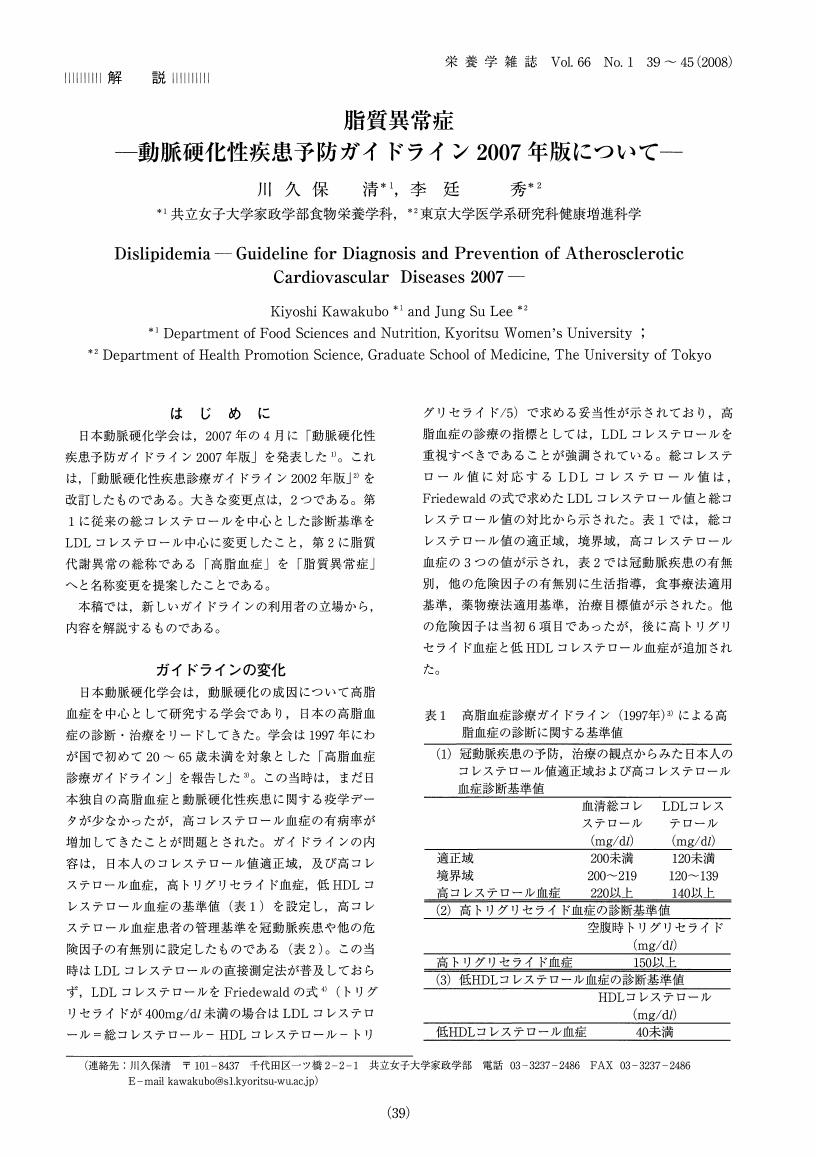- 著者
- 大久保 清朗
- 出版者
- 日本映像学会
- 雑誌
- 映像学 (ISSN:02860279)
- 巻号頁・発行日
- vol.106, pp.124-128, 2021-07-25 (Released:2021-08-25)
4 0 0 0 OA 「七年戦争」下プロイセンの戦費財政
- 著者
- 久保 清治
- 巻号頁・発行日
- vol.5, pp.73-122,
2 0 0 0 OA 第41回循環器負荷研究会 運動負荷試験における事故に関する検討 全国107施設調査結果
2 0 0 0 IR 「7年戦争」後のプロイセン財政と間接税収入
- 著者
- 久保 清治
- 出版者
- 横浜商科大学
- 雑誌
- 横浜商科大学紀要 (ISSN:03862992)
- 巻号頁・発行日
- no.6, pp.p97-136, 1987
2 0 0 0 IR 段階圧力ストッキング着用が自転車運動中の呼吸循環機能に及ぼす影響
- 著者
- 山鹿 由莉 川久保 清 Yuri Yamaga Kiyoshi Kawakubo
- 出版者
- 共立女子大学
- 雑誌
- 共立女子大学家政学部紀要 (ISSN:03883612)
- 巻号頁・発行日
- no.60, pp.97-101, 2014-01
1 0 0 0 兵庫県におけるイノシシの被害実態と防止対策
- 著者
- 足立 年一 久保 清 山下 優勝
- 出版者
- 関西病虫害研究会
- 雑誌
- 関西病虫害研究会報 (ISSN:03871002)
- 巻号頁・発行日
- vol.24, pp.5-10, 1982
- 被引用文献数
- 1
兵庫県におけるイノシシの生態や行動習性, 農作物の被害実態について聞き取り調査を行うとともに, 電気柵によるイノシシの侵入防止の現地試験を併せて実施した.<BR>1. 被害を受ける農作物には水稲・イモ類・マメ類・栗・柿・竹の子などがあり, なかでも水稲の被害程度が高い.<BR>2. 兵庫県下の生息状況は捕獲数と被害面積から判断すると, 昭和48~51年頃 (約7,800頭捕獲/年) をピークに減少傾向を示している.<BR>3.イノシシは夜行獣で, 夜出没して農作物に被害を与える. ヌタうち, スリ木, きばかけなどの習性がある.<BR>4. イノシシは12月~2月に交尾を行い, 妊娠期間は約120日で4~6月頃出産し, 普通4~6頭産仔する.<BR>5. 餌のし好性を飼育イノシシでみると, 熟柿, サワガニ, 腐植土, 栗, マオ, クズの葉, シュズダマ, サツマイモのつるなどや, 野ネズミ, ヘビ類, ミミズなどの小動物を食べ, 非常に雑食性である.<BR>6. 電気柵による侵入防止効果試験において, 夜光塗料塗布線区ではイノシシの侵入を防止することはできなかった. 電気柵 (ポリステンレス線3~4段張り) 区では, 最初配線不備なところから侵入したが, 設置面を平らにし, 完全に配線したのちは, イノシシの侵入を防止することができた.
1 0 0 0 中高年女性の水中歩行時の呼吸循環系および代謝系応答
1 0 0 0 訣別の章 : 大久保清さん獄中手記
1 0 0 0 五島民俗図誌
- 著者
- 久保清, 橋浦泰雄 共著
- 出版者
- 一誠社
- 巻号頁・発行日
- 1934
1 0 0 0 IR 国債累増の財政的帰結--わが国財政危機の一側面
- 著者
- 久保 清治
- 出版者
- 横浜商科大学学術研究会
- 雑誌
- 横浜商大論集 (ISSN:02876825)
- 巻号頁・発行日
- vol.30, no.1, pp.48-77, 1996-05
1 0 0 0 生活習慣病といわれる成人病
1 0 0 0 OA 脂質異常症
- 著者
- 川久保 清 李 廷秀
- 出版者
- 特定非営利活動法人 日本栄養改善学会
- 雑誌
- 栄養学雑誌 (ISSN:00215147)
- 巻号頁・発行日
- vol.66, no.1, pp.39-45, 2008-02-01 (Released:2010-04-30)
- 参考文献数
- 7
- 著者
- 中島 敏明 杉本 恒明 川久保 清 戸田 為久 三輪 篤子 村川 祐二 野崎 彰 倉智 嘉久 天野 恵子 坂本 二哉 真島 三郎 伊原 正 田中 博 古川 俊之
- 出版者
- The Japanese Society of Electrocardiology
- 雑誌
- 心電図 (ISSN:02851660)
- 巻号頁・発行日
- vol.6, no.3, pp.237-246, 1986
肥大型心筋症 (HCM) の再分極異常の成因を知る目的で, QRST isointegral mapを作成し, 安静時および運動負荷後の分布を検討した.対象は, 正常群10例, HCM群35例 (閉塞型HOCM10例, 非閉塞型HNCM15例, 心尖部型APH10例) である.安静時QRST isointegral mapは, 正常群では左前胸部に極大を, 右胸部上方に極小をもつ分布を示したが, HCMでは , HOCM40%, HNCM60%, APH90%に, 左前胸部に極小をもつ異常分布がみられた.極小点は, APHではV<SUB>4, 5</SUB>周辺に, HNCMではV<SUB>5</SUB>に, HOCMではばらつく傾向があり, 各病型による多少の差異をみとめたが, 重複する例も多くみられた.安静時QRST isointegral mapの異常例に対し, 運動負荷後の分布の変化につき検討した.APHでは9例中8例において, 左前胸部の極小は, 右胸部上方に偏位し, ほぼ正常な分布を示した.HNCMでは9例中8例は, 負荷後も安静時と同様の異常分布を示した.HOCM4例では負荷後左前胸部下方に極小が偏位する傾向がみられた.以上より, HCMの再分極異常は主として1次性変化と考える.また, 運動時変化がHCMの病型で異なったことは, 心筋の肥厚形態の他に, 心筋自体の性質の差による可能性があり, HCMにおける再分極異常の成因は単一のものではないことが示唆される.
1 0 0 0 OA 関西国際空港緩傾斜護岸工事における盛土施工管理システム
- 著者
- 浜田 一 久保 清志 赤井 一之 中條 主也
- 出版者
- 公益社団法人 土木学会
- 雑誌
- 海洋開発論文集 (ISSN:09127348)
- 巻号頁・発行日
- vol.4, pp.21-26, 1988 (Released:2010-03-17)
- 著者
- 笠原 悦夫 松岡 芳子 冨田 真佐子 堀 祥子 村山 隆志 李 延秀 川久保 清
- 出版者
- 公益社団法人日本産業衛生学会
- 雑誌
- 産業衛生学雑誌 (ISSN:13410725)
- 巻号頁・発行日
- vol.44, 2002-03-20
- 著者
- 原田 亜紀子 川久保 清 李 廷秀 岩垂 信 池田 千恵子 茂住 和代 南 伸子
- 出版者
- 日本体力医学会
- 雑誌
- 体力科學 (ISSN:0039906X)
- 巻号頁・発行日
- vol.50, no.2, pp.229-236, 2001-04-01
- 被引用文献数
- 9 1
The purpose of this study was to evaluate the validity of two different measures of physical activity under normal living conditions. The 24-hour physical activity diary method (24 HD) and accelerometer (Lifecorder) were analyzed. Total daily energy expenditure (TDEE) and daily variation of energy expenditure (EE) were compared employing the two measures in conjunction with the minute-by-minute heart rate method (Flex HR) in middle-aged people with a mean age of 57.9 yr (N=17), and in young people (college students) with a mean age of 23.5 yr (N=11). The TDEE as measured by the 24 HD and Lifecorder was 2576.4±514.7 kcal・d^<-1> and 1973.1±290.2 kcal・d^<-1> respectively. The TDEE as measured by the Flex HR method was 2718.3±625.5 kcal・d^<-1>. The TDEE as measured by the Lifecorder method was significantly lower than that of the Flex HR method (p<0.01). The correlation coefficient (r) for the 24 HD and Flex HR measured values for TDEE (kcal/day) was 0.64 (p<0.01), and that for Lifecorder and Flex HR was 0.38. The daily variation of energy expenditure pattern measured by Lifecorder was similar to that of the Flex HR 24 HD measurements, on the other hand, were slightly lower than Flex HR measurements during the afternoon period. The 24 HD method was reasonably accurate in the testing. The daily variation of energy expenditure measured pattern by Lifecorder was similar to that of the Flex HR method l but the fact that the TDEE results were underestimated suggests that the Lifecorder method has merit in the measurement of daily activity patterns. It follows from this that to improve measurement of the TDEE, it is necessary to modify the Lifecorder method of calculating the algorithm.




